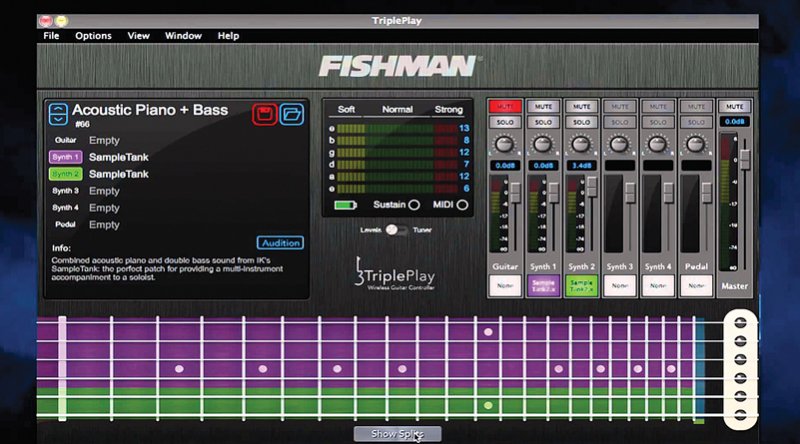Gear Review: Fishman TriplePlay
Gear Review: Fishman TriplePlay
The technology used in TriplePlay is based on the controller interpreting the strings vibration that is detected by the pickup. So to be fair this does make guitar MIDI slightly slower than usual keyboard MIDI. Instead of a strike of the key the controller has to detect a cycle of the notes frequency before passing the message on, which inevitably introduces latency.
With Fishman’s TriplePlay this works out an average of about 10ms latency. Giving that some perspective, in order to get this similar guitar MIDI functionality in the past I experimented with a 1987 Roland GM-70/ GK-1 combo which had a response of around 45ms. Sure 25 years is an eon in technology development terms, but by that comparison the TriplePlay is a revelation in faster response with great tracking of velocity and pitch, including bends.
To get started its recommended to install the included TriplePlay application (Mac or Windows) for the calibration utilities for optimising pickup position. No CD in the box so the software must be downloaded from the Fishman site after registering – factor this into your set up time.
 Mounting the compact TriplePlay controller is by way of a magnetic mount that uses (supposedly) safe adhesive direct to your guitar, or by one of two different brackets that attach to the strap post. I have this installed on a Vox SDC-55 guitar that has a carved top, so I used the angle bracket which sits very flush and feels solid.
Mounting the compact TriplePlay controller is by way of a magnetic mount that uses (supposedly) safe adhesive direct to your guitar, or by one of two different brackets that attach to the strap post. I have this installed on a Vox SDC-55 guitar that has a carved top, so I used the angle bracket which sits very flush and feels solid.
The hexaphonic pickup, which is connected to the controller by a short wire that sits next the saddle on one of four different height mounting pads. This adheres to the guitar with its own backing tape, or by either of the two Tune-O-Matic style bridge brackets. The pickup clicks into this mounting pad and can be easily detached by an upwards sliding motion allowing both it and the magnetically attached controller unit to be pulled off in a few seconds for charging, cleaning etc.
It’s a well-considered kit and I am sure almost all electric guitars will be easily catered for. Charging is by USB cable and full battery lasts around 20 hours. Just basic Bluetooth pairing for the first use of the USB dongle connected to your computer (or iPad) and you are good to go – no drivers required.
First stop might as well be the TriplePlay app again, as it is an excellent host to jam in. This app allows you to set up, mix, edit and store patches of multiple synths and contains outrageous depth with layers, zones and splits. You can blend all this with your guitars real audio modeled and effected, if connected to your computers audio input.
On the controller a solid 3-way toggle switch is there for quickly selecting between guitar, synth or both, and along with a handy MIDI volume control, a 4-way set of buttons provides the ability to wirelessly navigate patches in the TriplePlay app.
Fishman makes TriplePlay the complete package by including a impressive suite of fully licensed software to work with straight way. But you can of course use TriplePlay as a MIDI controller for conceivably any MIDI-based software, for example Logic Pro which recognised the input immediately.
 A review of the included software bundle is outside the scope of this brief review but as a quick run down you get the impressive Native Instruments Kontakt Elements pack (with over 3GB of samples!), and for amp modeling and effects if you have the normal audio from your guitar connected to your computer input, Native’s GuitarRig LE, IKs Sample Tank 2 XT and AmpliTube Custom Shop. These are all AU/VST so can also be used in most DAW programs.
A review of the included software bundle is outside the scope of this brief review but as a quick run down you get the impressive Native Instruments Kontakt Elements pack (with over 3GB of samples!), and for amp modeling and effects if you have the normal audio from your guitar connected to your computer input, Native’s GuitarRig LE, IKs Sample Tank 2 XT and AmpliTube Custom Shop. These are all AU/VST so can also be used in most DAW programs.
For recording and arranging you get Presonus Studio One Artist DAW software and Notions Progression composition and notation chart writers app. So a great included bundle with a mind-bending amount of ready-to-play sounds and music making software, that certainly provides genuine tools for any level of musician, for studio and/or live.
While the technology of synth guitars is not new, dating back at least to the 1970s, what Fishman have done with the TriplePlay is to blend the latest pitch detection technology with the convenience of wireless Bluetooth, easy installation and a set of useful and great sounding software. Bravo.
Darin King played guitar and drums before turning to electronics and DJing, leading to a 10 year stint as the house engineer and a resident DJ at Auckland’s Fu Bar. He’s currently producing electronic music using primarily hardware synths.
